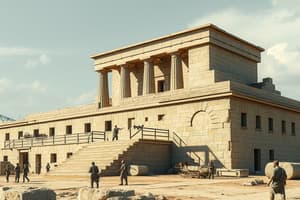Podcast
Questions and Answers
What is the primary focus of the AP World History unit 1 exam?
What is the primary focus of the AP World History unit 1 exam?
- The impact of the Mongol Empire
- The rise of European nations
- The significance of the Crusades
- The development of major civilizations around the world (correct)
What philosophical concept defined Chinese culture during the Song Dynasty?
What philosophical concept defined Chinese culture during the Song Dynasty?
- Daoism
- Taoism
- Confucianism (correct)
- Buddhism
What was the primary method of earning bureaucratic jobs during the Song Dynasty?
What was the primary method of earning bureaucratic jobs during the Song Dynasty?
- Civil service examination based on Confucian classics (correct)
- Military conquest
- Nepotism
- Social connections
What social practice was prevalent in China during the Song Dynasty, limiting women's mobility?
What social practice was prevalent in China during the Song Dynasty, limiting women's mobility?
Which neighboring regions were influenced by China's tactics to maintain its rule?
Which neighboring regions were influenced by China's tactics to maintain its rule?
What was the central concept of Confucianism that emphasized the importance of children's obligations to their parents and ancestors?
What was the central concept of Confucianism that emphasized the importance of children's obligations to their parents and ancestors?
What was the primary focus of Mahayana Buddhism in East Asia?
What was the primary focus of Mahayana Buddhism in East Asia?
What was the economic impact of innovations in agriculture and transportation during the Song Dynasty?
What was the economic impact of innovations in agriculture and transportation during the Song Dynasty?
What was the common feature of the legal systems of the new Turkic Muslim empires?
What was the common feature of the legal systems of the new Turkic Muslim empires?
What was the primary role of Sufi mystics in the expansion of Muslim rule?
What was the primary role of Sufi mystics in the expansion of Muslim rule?
What was the impact of the bhakti movement on traditional Hinduism?
What was the impact of the bhakti movement on traditional Hinduism?
What was the outcome of the Delhi Sultanate's attempt to extend Muslim rule into the South?
What was the outcome of the Delhi Sultanate's attempt to extend Muslim rule into the South?
Flashcards
Song Dynasty
Song Dynasty
Chinese dynasty (960-1279) known for its strong bureaucracy, Confucian values, and economic expansion.
Confucianism
Confucianism
Chinese philosophy emphasizing hierarchical social order, filial piety, and respect for elders.
Filial piety
Filial piety
Respect for and obedience to parents and elders.
Imperial bureaucracy
Imperial bureaucracy
Signup and view all the flashcards
Civil service examination
Civil service examination
Signup and view all the flashcards
Dar al-Islam
Dar al-Islam
Signup and view all the flashcards
Seljuk Empire
Seljuk Empire
Signup and view all the flashcards
Sharia law
Sharia law
Signup and view all the flashcards
Golden Age of Islam
Golden Age of Islam
Signup and view all the flashcards
Bhakti movement
Bhakti movement
Signup and view all the flashcards
Aztec Empire
Aztec Empire
Signup and view all the flashcards
Inca Empire
Inca Empire
Signup and view all the flashcards
Mississippian culture
Mississippian culture
Signup and view all the flashcards
Swahili Civilization
Swahili Civilization
Signup and view all the flashcards
Byzantine Empire
Byzantine Empire
Signup and view all the flashcards
Kievan Rus'
Kievan Rus'
Signup and view all the flashcards
Feudalism
Feudalism
Signup and view all the flashcards
Manorialism
Manorialism
Signup and view all the flashcards
Study Notes
Here is the summary:
• The AP World History unit 1 exam covers the period from circa 1200 to 1450, focusing on various major civilizations around the world and how they built and maintained their states.
• In the context of AP World History, a "state" refers to a territory politically organized under a single government, such as the United States or Japan.
• The Song Dynasty in China ruled from 960 to 1279 and maintained its rule through two main methods: emphasizing Confucianism and expanding the imperial bureaucracy.
• Confucianism is a philosophy that defined Chinese culture, emphasizing the hierarchical nature of society, with those above needing to care for those below, and those below needing to defer to those above.
• The concept of filial piety was central to Confucianism, emphasizing the importance of children obeying and honoring their parents and ancestors.
• During the Song Dynasty, women were relegated to a subordinate position, stripped of legal rights, and endured social restrictions, such as limited access to education and the practice of foot binding.
• The imperial bureaucracy grew in scope during the Song Dynasty, with bureaucratic jobs earned through a civil service examination based on Confucian classics, theoretically open to men of all socioeconomic statuses.
• The tactics used by China to maintain its rule influenced neighboring regions, such as Korea, Japan, and Vietnam, which adopted similar civil service examinations and Buddhist practices.
• Buddhism originated in India and spread to China, emphasizing the Four Noble Truths, the cycle of death and rebirth, and the ultimate goal of achieving Nirvana.
• Mahayana Buddhism, which emerged in East Asia, encouraged broader participation in Buddhist practices and emphasized the role of bodhisattvas in helping others achieve Enlightenment.
• The Song Dynasty's economy was commercialized, with manufacturers and artisans producing excess goods for trade in markets across Eurasia, leading to a population explosion.
• Innovations in agriculture, such as the introduction of Champa rice, and transportation, such as the expansion of the Grand Canal, facilitated the growth of the Song economy.
• The term "Dar al-Islam" refers to the regions where Islamic faith was the organizing principle of civilizations, including the Middle East, North Africa, and parts of Europe.
• During this period, Islamic empires were dominated by Turkic people, rather than Arabs, and new empires such as the Seljuk Empire, Mamluk Sultanate, and Delhi Sultanate emerged.
• The Seljuk Empire was established in Central Asia by Turkic pastoralists and eventually displaced the Abbasid Empire, which had been the dominant Islamic power.
• The new Turkic Muslim empires continued some practices from the former Abbasid Empire, such as establishing Sharia law as the organizing principle of their legal systems.
• Muslim scholars made significant advances in mathematics, preserved ancient Greek and Roman manuscripts, and translated them into Arabic, contributing to the Golden Age of Islam.
• The expansion of Muslim rule throughout Afro-Eurasia occurred through military expansion, trade, and missionary activities of Sufi mystics.
• In South Asia, three main religions vied for dominance: Hinduism, Buddhism, and Islam, with Hinduism remaining the most widespread religion and Islam becoming the second most important.
• The bhakti movement emerged in southern India as an innovation on traditional polytheistic Hinduism, emphasizing devotion to one of the Hindu gods and challenging social and gender hierarchies.
• In Southeast Asia, Buddhism and Islam competed for dominance, with Buddhism remaining strong in regions such as Sri Lanka and Islam spreading throughout the region.
• The Delhi Sultanate ruled much of northern India, but faced resistance from Hindu kingdoms such as the Rajput Kingdom and the Vijayanagara Empire.• The Delhi Sultanate's attempt to extend Muslim rule into the South failed, as emissaries sent to the South converted back to Hinduism and established a rival empire.
• The Majapahit Kingdom, a Buddhist kingdom in Java (1293-1520), was one of the most powerful states in Southeast Asia, maintaining its influence through controlling sea routes for trade.
• The Majapahit Kingdom began to decline when China started supporting its trading rival, the Sultanate of Malacca.
• The Khmer Empire, a Hindu kingdom that converted to Buddhism, built the magnificent Angkor Wat temple, which reflects both Hindu and Buddhist elements.
• By 1200, the majority of the population in the Americas lived in two major centers of civilization: Mesoamerica and the Andean civilization.
• The Aztec Empire, founded in 1345, was a massive empire with an elaborate system of tribute states, where conquered people provided labor and goods to the Aztecs.
• The Aztecs also practiced human sacrifice, which was a major part of their belief system.
• The Inca Empire, founded in the early 1400s, stretched across the Andean Mountain Range, and maintained power through an elaborate bureaucracy and rigid hierarchies of officials.
• The Inca Empire required all people under their rule to provide labor on state projects, such as large state farms, mining, and military service.
• The Aztecs were decentralized in their rule, while the Incas were highly centralized.
• The Mississippian culture, the first large-scale civilization in North America, grew around the Mississippi River Valley, focusing on agriculture and building monumental mounds.
• The Swahili Civilization, a series of cities organized around commerce, grew influential over time as they became involved in the Indian Ocean trade.
• The Swahili cities shared a common social hierarchy that put the merchant elite above commoners, and were deeply influenced by Muslim traders, which led to the emergence of the Swahili language.
• The Swahili States rapidly became Islamic, which increased their integration into the larger world of Islamic trade.
• In West Africa, powerful and highly centralized civilizations grew, including the Ghana, Mali, and Songhai Empires, driven by trade and influenced by Islam.
• The Hausa Kingdoms, a series of city-states, were organized around trade and shared a common culture and language.
• The Great Zimbabwe, a powerful African state, grew wealthy through trade and farming, and maintained its indigenous shamanistic religion.
• The Kingdom of Ethiopia, a Christian state, grew and flourished through trade, especially with states around the Mediterranean and Arabian Peninsula.
• In Europe, belief systems were dominated by Christianity, with two different flavors: Eastern Orthodox and Roman Catholic.
• The Byzantine Empire, representing the eastern half of the once-massive Roman Empire, was nearly breathing its last breath by 1200.
• The Kievan Rus', a new state that emerged, carried the Eastern Orthodox belief system forward and united people through the adoption of Eastern Orthodox Christianity in 988.
• In Western Europe, the Roman Catholic Church linked states together culturally, with a hierarchy of popes, priests, and bishops spread throughout Europe.
• Politically, there were no large empires in Europe during this period, but decentralization and political fragmentation were the dominant features.
• Feudalism, a system where powerful lords and kings gained allegiance from lesser lords and kings in exchange for land and military service, was the main social, political, and economic order across Europe.
• Minorialism, a system where peasants worked on land owned by lords in exchange for protection, was the dominant economic order in Europe during this period.
Studying That Suits You
Use AI to generate personalized quizzes and flashcards to suit your learning preferences.




